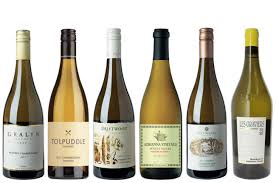BEER & WINE: 7 Chardonnays for People Who Think They Hate Chardonnay
.
:max_bytes(150000):strip_icc():format(webp)/chardonnays_main_720x720-70f36ae667de43049e04d37585d0bd7a.jpg)
Image:
Liquor.com / Laura Sant
.
The grape goes far beyond the much-loathed buttery and over-oaked bottles.
It’s a common refrain: “I hate chardonnay.” So much so, in fact, that a whole movement has sprung up around it—the ABC faction. You guessed it. That stands for Anything But Chardonnay.
The ubiquitous grape had a substantial heyday in the 1980s and ’90s, when a lot of New World producers were attempting to emulate the revered white wines of Burgundy, France. But as chardonnay skyrocketed in popularity, wineries scrambled to make the wine accessible to the masses. The ’80s were an age of excess, and that was reflected in the wines of the time, which became increasingly more opulent and flamboyant as they gained their massive following.
Chardonnay in and of itself is actually a relatively neutral variety, meaning that it’s not particularly aromatic or overpowering. In Burgundy, chardonnay makes some of the finest white wines in the world because of its striking ability to transmit a sense of place wherever it’s grown. And there aren’t many places to grow wine better than Burgundy.
But in their pursuit of excess, the winemakers of the United States, South America and Australia wanted their wines to get bigger and bigger, bolder and bolder. Since chardonnay’s inherent characteristics typically take a back seat to the effects of location and winemaking techniques, it serves as an excellent canvas for the style those winemakers were trying to achieve, often through the effects of oak and malolactic fermentation.
A chardonnay’s characteristics depend in part on the type of oak barrels used (or in the case of some very inexpensive wines, oak staves or chips). Wines that spend time in new oak can have aromas and flavors that range from vanilla and coconut to cedar and spice. And then there’s that famous buttery flavor, which comes from malolactic fermentation, a process that converts harsh malic acid (like what you’d find in a green apple) to softer, gentler lactic acid (think Greek yogurt). Winemakers also frequently used to leave a fair bit of residual sugar in the bottle, leading to many of these wines bordering on dessert status. Without these winemaking methods, chardonnay is a fairly mellow and low-key variety with bright fruit flavors and often a pleasant streak of minerality.
So when people say, “I hate chardonnay,” they almost never mean they dislike the chardonnay grape itself. What they’re referring to are the winemaking techniques that have become virtually synonymous with the variety over the years.
The good news is that there’s a whole world out there of chardonnays that don’t rely on oak, malolactic fermentation or sugar to achieve their flavor profiles or that use them sparingly and with great balance. Some regions, like Burgundy, have been doing it this way for centuries, while others, such as parts of California, have only recently experienced a pendulum swing toward varietally pure and expressive chardonnays, thanks in large part to a growing backlash against the excesses of past decades.
If you historically have not been a fan of the variety, there’s never been a better time to get reacquainted and learn what chardonnay can do when it’s allowed to be itself. These are seven great examples to get you started on your journey.
.2018 Chacra Mainque (Patagonia, Chile; $39)
-
:max_bytes(150000):strip_icc():format(webp)/chardonnays_mainque_720x720-025f6a1a5ae44960ab6b2c0e40bbfe6f.jpg)
Liquor.com / Laura Sant Unlike Burgundy, Chile is known for its budget-friendly wines, so it may come as a surprise even to serious wine professionals that a chardonnay of this caliber is being made here. Chacra founder Piero Incisa comes from the legendary Italian wine family known for Sassicaia, but he has made his own mark in Chile with this gorgeous Burgundy-inspired chardonnay aged in neutral barrels and marked by bright, saline minerality.
SPACE RESERVE FOR ADVERTISEMENT.
2016 Day Wines Belle Pente Vineyard (Yamhill-Carlton, Ore.; $36)
-
:max_bytes(150000):strip_icc():format(webp)/chardonnays_day_720x720-6f384d59ec7f4051ba563462a828d7bc.jpg)
Liquor.com / Laura Sant Willamette Valley winemaker Brianne Day somehow manages to do amazing things to wine by, well, not doing much to the wine at all. She’s all about minimal intervention, letting the grapes ferment and do their own thing. That makes her chardonnay a perfect choice for those who want to focus on the fruit. She uses 33% new oak here, but you’ll find when it’s integrated this well it’s a welcome addition.
SPACE RESERVE FOR ADVERTISEMENT -
:max_bytes(150000):strip_icc():format(webp)/chardonnays_moreau-naudet_720x720-878c4659431349b1b382c0fd13047f12.jpg)
Liquor.com / Laura Sant The coolest, northernmost tip of Burgundy is responsible for some of the steeliest, most mineral-driven expressions of chardonnay you’ll find anywhere. Domaine Moreau-Naudet is part of a new generation of producers focused on fresh, accessible and ridiculously drinkable wines. This bottling is a prime example of the flinty wet-stone character you’ll find in some of the best cool-climate chardonnays.
SPACE RESERVE FOR ADVERTISEMENT -
:max_bytes(150000):strip_icc():format(webp)/chardonnays_arbois_720x720-4b9e56e65c5844948b87deee197ea21c.jpg)
Liquor.com / Laura Sant When talking about French chardonnay, Burgundy tends to get all the attention, but the Jura region in eastern France is a hidden treasure for lovers of light-bodied reds and richly flavored whites. Here, chardonnay often is made in an intentionally oxidative style, giving it a unique and delightful savory and nutty character. This one by Domaine Rolet is marked by a pleasing hint of hazelnut, with minimal use of oak to add texture.
SPACE RESERVE FOR ADVERTISEMENT.
-
:max_bytes(150000):strip_icc():format(webp)/chardonnays_kumehu-river_720x720-95feeabcd81c44eead3e74216083a749.jpg)
Liquor.com / Laura Sant Kumeu River is another winery producing wines of exceptional quality in a country more commonly recognized for value. New Zealand is also much better known for sauvignon blanc than chardonnay, but don’t let that deter you. If you like the cool, crisp citrus notes of a New Zealand sauv blanc, you’ll appreciate the same qualities in this approachable food-friendly chard.
SPACE RESERVE FOR ADVERTISEMENT.
2017 Petit Chapeau Bourgogne Blanc (Burgundy, France; $23)
-
:max_bytes(150000):strip_icc():format(webp)/chardonnays_petit-chapeau_720x720-8de6232cc70d4f8693895584d0ebc6e2.jpg)
Liquor.com / Laura Sant Burgundy isn’t exactly known for its value-priced wines, but this bottle is here to show you that great and affordable wine is indeed possible there. Created by superstar sommelier Daniel Johnnes in collaboration with producers in Burgundy, this characterful gem is bright, vibrant and easy, made without a hint of oak. There’s full malolactic fermentation here, but in this case it adds texture and appeal without veering into buttery territory.
SPACE RESERVE FOR ADVERTISEMENT.
2017 Trail Marker Wine Co. Manchester Ridge (Mendocino, Calif., $38)
-
:max_bytes(150000):strip_icc():format(webp)/chardonnays_manchester-ridge_720x720-7f5bc44864f4437f8dc4f0756659a3d5.jpg)
Liquor.com / Laura Sant If you like your white wines bone dry with searing minerality, this one by Trail Marker is for you. Pure and saline but with deliciously ripe fruit, it spends some time in previously used oak barrels, which lend lovely texture but don’t impact the flavor of the wine. The moment you pop it open, it begs to be paired with freshly shucked oysters and lots of them.
.




:strip_icc():format(webp)/pinot-noirs_main_720x720-46d54d1ce75949e48dbdde15b606ba38.jpg)
:strip_icc():format(webp)/terquilamain-3b8b97cf6497463bb416221a6b1227f0.jpg)
:strip_icc():format(webp)/champagnemain-8e7d19afee3a4c24a7b53b15c7ff1263.jpg)
:strip_icc():format(webp)/dessert-wines_main_720x720-0fd6194e3086451ca50cd2440d1fa69a.jpg)
:strip_icc():format(webp)/regional-italian-wines_main_720x720-bd2fca796ddf47e9bab6f93b5d9f3367.jpg)
:strip_icc():format(webp)/virtual-wine-tours_Carmel_Valley_Folktale_1-Winery_Lisa_Corson-4883_Full_Rights_main_720x720-b0e7039a99ca4c94afea23a38f09290e.jpg)
:strip_icc():format(webp)/__opt__aboutcom__coeus__resources__content_migration__liquor__2017__03__21122928__6-Rules-for-Drinking-Canadian-Whisky-720x720-article-29e6a0ea1ecb436f9483597ab74b59d9.jpg)
:strip_icc():format(webp)/bourbonmain-f5239da19fcb4ce98cc27efdf135b3e2.jpg)
:strip_icc():format(webp)/mainrum-01ecf6b5df3f42bba212d416a24b263a.jpg)
:strip_icc():format(webp)/vodkamain-0f5af032578a41ebb38cf307c059b371.jpg)
:strip_icc():format(webp)/cabsauv_main_720x720-6ebdd28b587e4c399271562faee2d1be.jpg)
:strip_icc():format(webp)/new-vodkas_main_720x720-09cbe19e0abb4e84942c77bd00455857.jpg)
:strip_icc():format(webp)/GettyImages-1058815020-98875ea8931b429796e0e6ef607d1812.jpg)
:strip_icc():format(webp)/wine-clubs_main_720x720-5a969b3f071d482eb2b6366bb11e0aee.jpg)
:strip_icc():format(webp)/roses-article_720x720-3cf9cc1983f1428d9cb1db244bee93df.jpg)
:strip_icc():format(webp)/wine-delivery_primary_720x720-a7f6134a458b44da9489c5da0a33b054.jpg)







